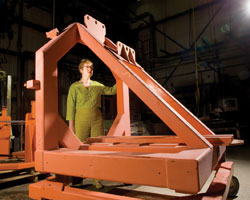 |
| Liz Buckley-Geer with the 850-pound mounting frame scavenged from Kitt Peak Photo: Reidar Hahn, Fermilab |
A recycling tale that's hard to top
There's luck, and then there is LUCK.
Brenna Flaugher has the latter.
During a trip to Kitt Peak National Observatory in Arizona to search for cosmic signs of dark energy, Flaugher took a break to walk around with fellow Fermilab astrophysicists Tom Diehl and Liz Buckley-Geer. Suddenly she pointed excitedly.
"I know what that is," she said. "I want that."
Halfway down the hill, partly hidden beneath a tree, lay a metal frame the size of a dune buggy. Not just any frame–the exact 850-pound frame Flaugher and Diehl needed to mount the world's largest digital camera onto a telescope.
This Dark Energy Camera will be mounted on the four-meter Blanco telescope in Chile, allowing scientists to take pictures of roughly 300 million galaxies as they existed when the universe was only a few billion years old.
The Blanco telescope happens to have a northern twin, the Mayall telescope at Kitt Peak. Flaugher had spied the Mayall's discarded mounting frame.
A little negotiation, a bit of planning to arrange shipping, and a little elbow grease to remove rust, and the duo had the perfectly useable frame sitting at Fermilab in Illinois, where the camera is under construction. Their scavenged part saved the experiment a couple of thousand dollars.
Tona Kunz
Click here to download the pdf version of this article.






